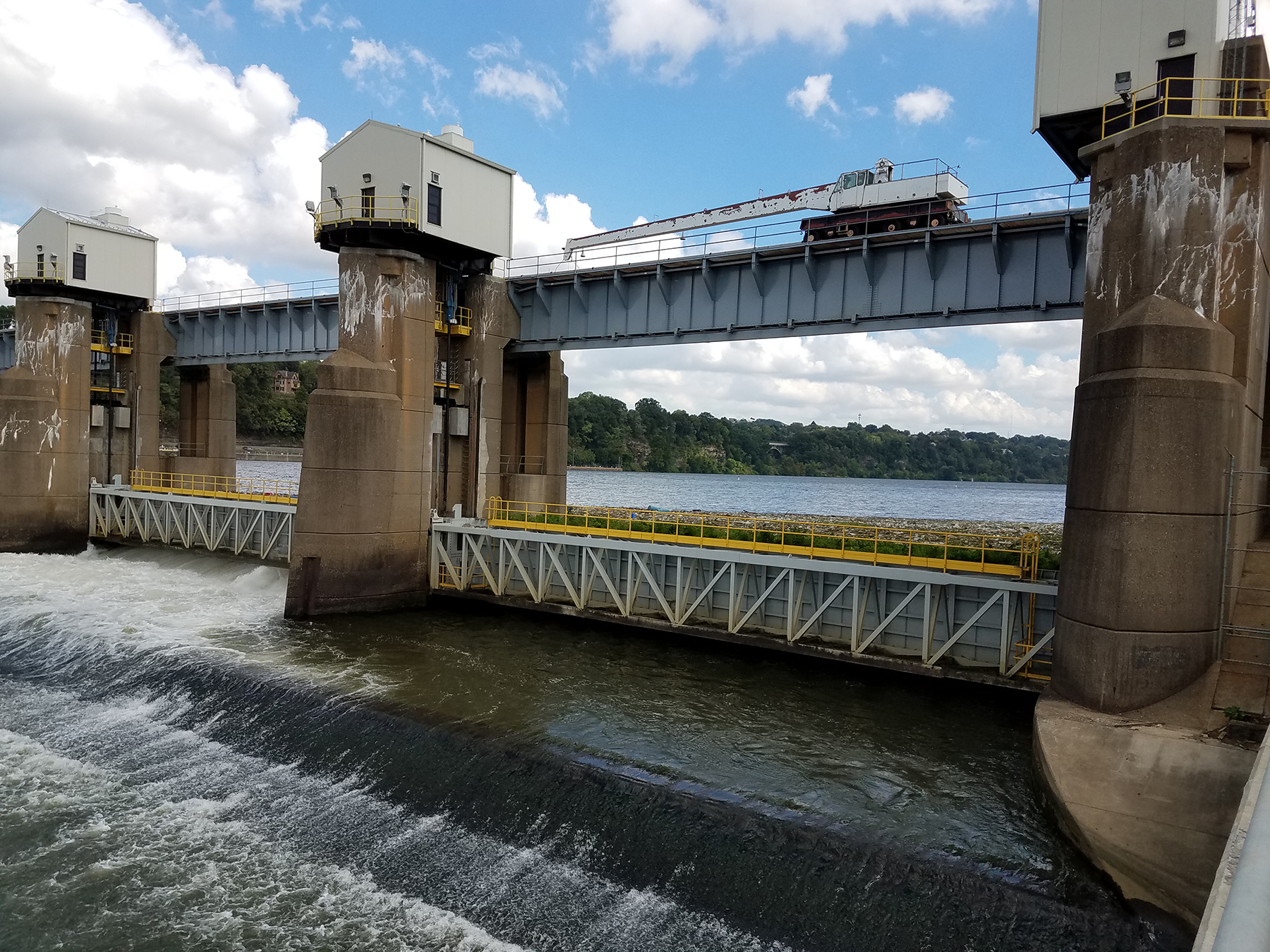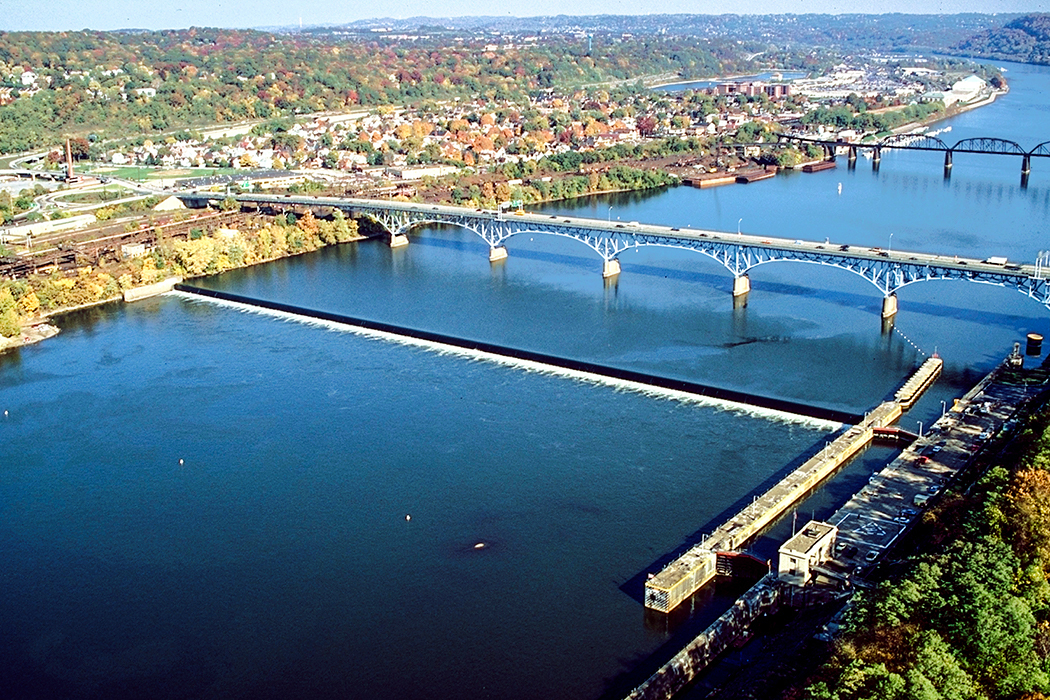By Jay Landers
Looking to serve the growing number of companies and government agencies seeking to fulfill goals or mandates regarding renewable energy use, a private developer is planning to construct multiple hydropower plants on existing lock and dam facilities owned by the Pittsburgh District of the U.S. Army Corps of Engineers. These and other “low-impact” hydropower projects planned by the developer are designed to provide renewable sources of reliable, continuous, carbon-free energy that avoid many of the negative environmental effects associated with the construction of dams and their attendant generation facilities.
Pittsburgh projects
Rye Development LLC, the hydropower company undertaking the Pittsburgh-area projects, is in the process of developing multiple hydropower projects around the United States. Rye plans to conduct a total of 10 projects in southwestern Pennsylvania, all of which are run-of-river in nature, meaning that they take advantage of existing lock and dam structures on waterways.
With its three major rivers — the Allegheny, Monongahela, and Ohio — the Pittsburgh region is “rich in water resources,” says Ushakar Jha, P.E., M.ASCE, Rye’s vice president of project engineering. What is more, the waterways boast numerous existing locks and dams that were designed to facilitate navigation but can be adapted to accommodate hydropower facilities, Jha says.

Aiming to take advantage of such opportunities, Rye approached the U.S. Federal Energy Regulatory Commission more than a decade ago to begin the process of obtaining licenses to add hydropower generation components to navigation facilities owned by the Corps. In essence, the projects will involve the installation of small powerhouses either immediately downstream of dam gates or within a dam itself to take advantage of the water flowing over the structure. The powerhouses are designed to be overtopped and submerged in the event that flows exceed certain levels, Jha says.
Power purchase agreements
Rye received initial approval to proceed on the projects from FERC in 2016. Since then, the company has entered into agreements to provide renewable energy to three parties, the most recent of which is data center operator Iron Mountain Inc. Under the terms of an agreement announced in mid-June, Iron Mountain has agreed to purchase up to 150 MW of power during the next decade from various hydroelectric projects planned by Rye.
The Iron Mountain deal is a “big milestone” because the hydropower to be purchased by the company is “not associated with any one project,” Jha says. “The idea here is that, on a programmatic level, they will look at taking around 150 MW of power from Rye projects. It could come from any number of projects, so that gives us a lot of flexibility.”
In 2019, Rye signed its first agreement with the University of Pittsburgh, which will receive on-demand renewable power generated by hydropower facilities to be constructed at the Corps’ structure known as the Allegheny River Locks and Dam 2. Along with providing a carbon-free source of renewable energy, the project will serve as an outdoor laboratory for students of the university, Jha says.
In 2020, Allegheny County entered into a 35-year agreement with Rye to purchase renewable energy from a hydropower project having a nameplate capacity of up to 20 MW to be constructed on the Corps facility on the Ohio River known as the Emsworth Locks and Dams.
Following its agreement with Allegheny County, Rye hired professional services and project management company SNC-Lavalin for help with designing its planned hydropower projects. Of the three projects for which Rye has power purchase agreements, the one involving the Emsworth Locks and Dams is expected to begin construction first.
Initial project
The Emsworth Locks and Dams facility includes two gated dams situated on either side of an island in the Ohio River. The dam on the main channel has eight gates, and the dam on the smaller channel, known as the back channel, has six gates. Two locks are located beside the main channel dam, while the back channel dam has no locks.
For the Emsworth main channel dam, Rye plans to construct a powerhouse immediately downstream of two of the gate bays, Jha says. To be located on the side of the dam opposite the locks, the powerhouse will have three turbines, each of which will have a capacity of approximately 6-6.5 MW. “Overall, it's going to produce almost 100,000 MWh annually,” Jha says.
To date, Rye has submitted the 30% design for the installation on the Emsworth main channel dam to the Corps as part of the agency’s design review process. Lasting 12-18 months, the review process begins with the submission of a preliminary design, followed by submissions at 30%, 60%, 90%, and 100% of design. Upon the completion of this process, the Corps and FERC will issue permits to Rye to begin construction.
Rye expects to submit the 60% design for the Emsworth main channel project by mid-2024, Jha says. “We are looking at that project coming online and providing electricity sometime by late 2027,” he says.
To expedite the design process, Rye plans to hire an engineering, procurement, and construction contractor this year to assist with the design work. Involving an EPC contractor at this stage of the design process is intended, in part, to help address the issue of constructability, Jha says. Because Rye’s projects interact with existing structures that, in some cases, might range in age from 50 to 70 years, constructability is a “major challenge,” he notes.
Design review
For its part, the Corps uses the design review process “to ensure that the project is compatible with (our) project operation,” says Eric Merriam, Ph.D., the chief of the Plan Formulation and Economics Section of the Corps’ Pittsburgh District.
“When reviewing proposed hydropower projects, the Corps is primarily assessing potential effects on the environment, public interest, and the usefulness of the Corps project as a whole,” Merriam says. “Essentially, the most prominent aspect of proposal evaluation is ensuring that the proposed development is not injurious to the public and will not impair the usefulness of the project.”
Besides assessing potential effects on the navigational capabilities of the Corps’ facilities, two “obvious things” to assess during the design review process involve ensuring that the new hydropower projects will not “cause any additional scouring or flooding,” Jha says.
Additional projects
The second project that Rye expects to complete involves the Allegheny River Locks and Dam 2. The structure consists of an approximately 1,400 ft long fixed-crest dam having no gates and a single lock chamber.
Currently at the 30% completion mark, the design for the project calls for a powerhouse with two turbines to be located on the dam itself, on the side opposite the lock chamber. “We will take out maybe around 150 ft of the dam structure to create a passage for river flow to get into the turbines,” Jha says. All told, the project will have a capacity of about 9 MW and “will produce somewhere around 50,000 MWh on an annual average basis,” he says.

For its third project in the Pittsburgh area, Rye plans to return to the Emsworth Locks and Dams facility and install a powerhouse with two turbines on the back channel dam. Similar to, but smaller than, the facilities planned for the main channel dam, the project will “occupy only one of the six gate bays” on the back channel dam, Jha says. With each turbine having a capacity of 6 MW, the project is expected to produce approximately 60,000 MWh on an annual average basis, he notes.
Ultimately, Rye is planning to construct another six run-of-the-river projects on Corps projects on the Monongahela River, ranging in generation capacity from 5 to 12 MW. Of these, three could be brought online between 2030 and 2032, Jha says.
Once a project is completed, Rye intends to have it accredited by the Low Impact Hydropower Institute, a nonprofit organization dedicated to reducing the impacts of hydropower generation through the certification of hydropower projects that have avoided or reduced their environmental effects in accordance with the institute’s criteria.
This independent, third-party certification is important for entities that are purchasing hydropower from Rye as part of efforts to achieve environmental, social, and governance goals for investment, Jha says. “That’s where getting a certification from LIHI is helpful.”
Longer term, Rye also has plans to develop run-of-the-river projects in Mississippi and Louisiana. Meanwhile, the company is pursuing multiple pumped-storage hydropower projects. Foremost among these are the nearly 400 MW Swan Lake Energy Storage Project in southern Oregon, the 1,200 MW Goldendale Energy Storage Project on the Oregon-Washington border, and the 287 MW Lewis Ridge Project in southeastern Kentucky.
This article is published by Civil Engineering Online.



